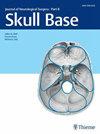腰部导管对内窥镜鼻内入路手术后脑膜炎发生率的影响
IF 0.9
4区 医学
Q3 Medicine
引用次数: 0
摘要
目的:内窥镜鼻腔内入路(EEA)手术由于直接通过鼻咽粘膜,因此本身就存在污染。据报道,EEA 手术的术后脑膜炎发生率在 0.7%-10% 之间。EEA 手术中使用腰椎导管是为了防止脑脊液(CSF)瘘,但使用腰椎导管会增加感染率。本研究调查了腰椎导管的使用是否会导致术后脑膜炎发生率的差异。方法:我们对 2016 年 1 月至 2023 年 3 月期间在单一机构(FLENI)接受 EEA 手术的连续患者进行了回顾性研究。主要结果结果:72名患者入选,中位年龄为44岁,53%为女性。最常见的手术是颅咽管瘤,占 46%(26 名患者)。28名患者使用了腰椎导管。72 例患者中有 11 例(15.2%)被诊断为脑膜炎,其中腰椎导管组的比例更高(10 例)。使用腰椎导管时发生脑膜炎的几率比为 23.38(95% 置信区间为 2.77-123.78;P <0.004)。出现脑脊液渗漏时,脑膜炎的报告发病率没有统计学差异。结论:本研究表明,使用腰椎导管进行 EEA 手术后,脑膜炎的发病率极高(36%)。在我们的队列中,脑膜炎的发生率与 CSF 渗漏无明显关联。本文章由计算机程序翻译,如有差异,请以英文原文为准。
Impact of the lumbar catheter on the incidence of post-surgical meningitis in the endoscopic endonasal approach
Objectives: Endoscopic endonasal approach (EEA) procedures are inherently contaminated due to direct access through the nasopharyngeal mucosa. The reported rate of postoperative meningitis in EEA procedures is between 0.7%-10%. Lumbar catheters are used in EEA surgeries to prevent cerebrospinal fluid (CSF) fistulae, but its use is associated with increase infection rates. This study investigated whether there is a difference in rates of postoperative meningitis based on lumbar catheter utilization.
Methods: We performed a retrospective review of consecutive patients who underwent EEA surgeries between January 2016 and March 2023 at single-institution (FLENI).
Main outcome: Incidence of meningitis following EEA surgery with lumbar catheter.
Results: seventy-two patients were enrolled, median age was 44 years, and 53% were female. Most frequent surgery performed was craniopharyngioma 46% (26 patients). Lumbar catheter was used in twenty-eight patients. Meningitis was diagnosis in 11 of 72 patients (15.2%), being higher in the lumbar catheter group (10 patients). The odds ratio for the development of meningitis in the presence of a lumbar catheter was 23.38 (95% confidence interval, 2.77-123.78; p < 0.004). There was no statistical difference in reported incidence of meningitis when CSF leak was present.
Conclusions: This study demonstrates an extremely high incidence of meningitis (36%) following EEA procedures when lumbar catheter is used. The incidence of meningitis was not significantly associated with CSF leak in our cohort.
求助全文
通过发布文献求助,成功后即可免费获取论文全文。
去求助
来源期刊

Journal of Neurological Surgery Part B: Skull Base
CLINICAL NEUROLOGY-SURGERY
CiteScore
2.20
自引率
0.00%
发文量
516
期刊介绍:
The Journal of Neurological Surgery Part B: Skull Base (JNLS B) is a major publication from the world''s leading publisher in neurosurgery. JNLS B currently serves as the official organ of several national and international neurosurgery and skull base societies.
JNLS B is a peer-reviewed journal publishing original research, review articles, and technical notes covering all aspects of neurological surgery. The focus of JNLS B includes microsurgery as well as the latest minimally invasive techniques, such as stereotactic-guided surgery, endoscopy, and endovascular procedures. JNLS B is devoted to the techniques and procedures of skull base surgery.
 求助内容:
求助内容: 应助结果提醒方式:
应助结果提醒方式:


